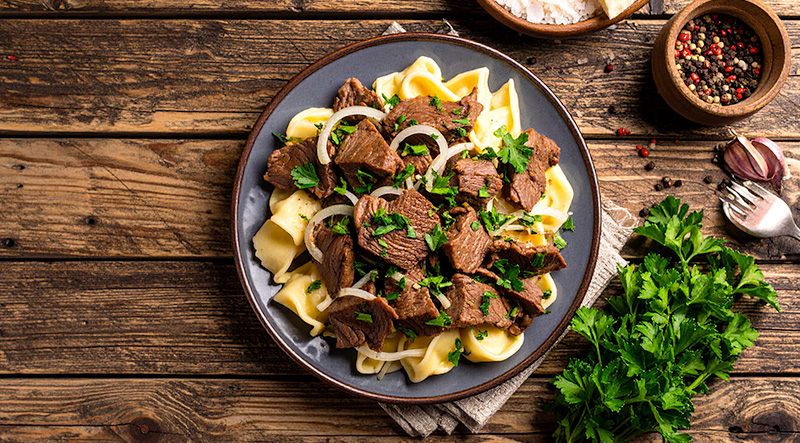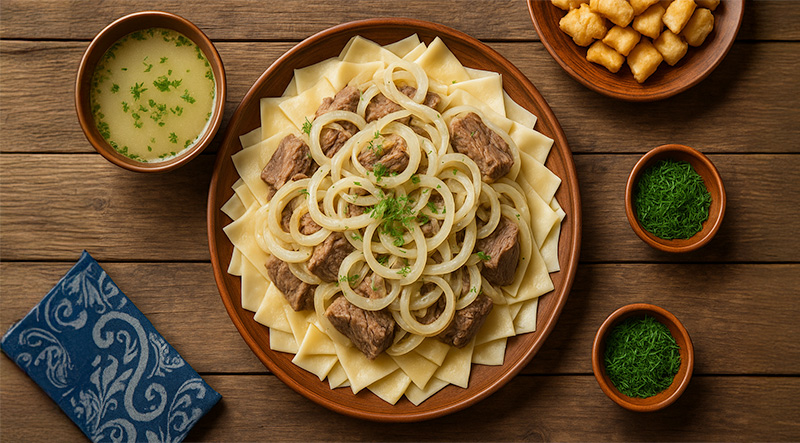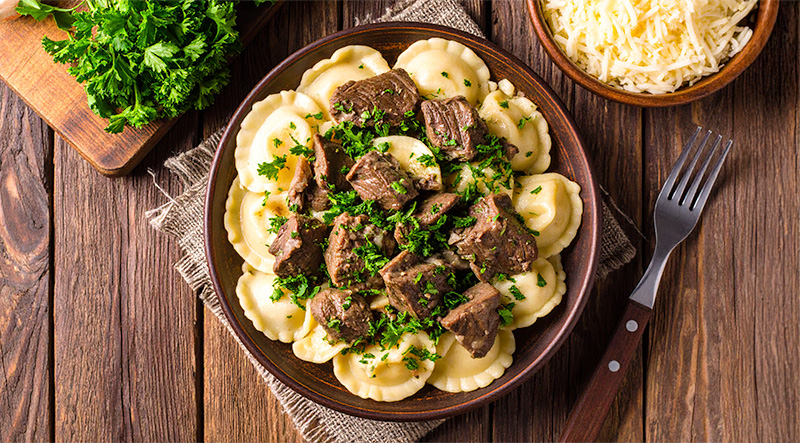Beshbarmak is the staple of Kyrgyz cuisine and the ultimate comfort food of the steppe. It is hearty, modest, and rich in tradition. This Kyrgyz national dish, which translates to "five fingers" in reference to the tradition of eating it by hand, consists of soft, boiled meat (typically lamb, beef, or horse) atop broad, smooth noodles, topped with soft-cooked onions and a dash of flavorful broth. This dish, which reflects Kyrgyzstan's nomadic past, is meant to be shared, celebrated, and told over a single platter of rich, rustic flavor. You can taste centuries of tradition in just one bite. Read More...
The History of Beshbarmak, Kyrgyzstan’s Beloved Culinary Heritage:
Beshbarmak — meaning “five fingers” in Kyrgyz — is more than just a traditional dish. It is a powerful culinary symbol of Kyrgyz identity, a dish deeply rooted in the country’s nomadic traditions, hospitality customs, and communal way of life. Served during weddings, funerals, national holidays, and family gatherings, Beshbarmak has remained a cherished centerpiece of Kyrgyz cuisine for centuries.
Origins in Nomadic Life:
The Kyrgyz people, like many Central Asian cultures, trace their roots to Turkic nomadic tribes who traversed the vast steppes and rugged mountains of the region. In these challenging landscapes, food needed to be practical, nourishing, and easy to prepare over open fires in yurts or while on the move.
Meat — especially from sheep, goats, and horses — was central to survival. Boiled meat, combined with simple hand-rolled noodles and savory broth, became the basis for what is now known as Beshbarmak. The name reflects how it was traditionally eaten: using the five fingers of the right hand, symbolizing simplicity and shared communal values.
Rituals and Respect:
In Kyrgyz culture, Beshbarmak is far more than a meal — it is a ritual of hospitality and social order. At traditional gatherings, the dish is served on a large communal platter, often in a yurt (boz üi). The meat is finely chopped or shredded, sometimes with great ceremony, and distributed by an elder or host to guests in a symbolic order — elders, honored visitors, and then the rest of the family.
Specific cuts of meat are given according to status and age, reflecting the deep-rooted etiquette in Kyrgyz customs. For example, the sheep’s head may be presented to the most respected guest, who is then expected to distribute symbolic parts to others — a gesture that demonstrates wisdom and generosity.
Regional Traditions and Variations:
While the core of Beshbarmak remains consistent — boiled meat, flat noodles, and onion broth (chyk) — there are notable regional variations within Kyrgyzstan. In the Naryn region, a version known simply as Naryn features ultra-thin noodles and finely diced meat, sometimes served cold with warm broth on the side.
In contrast, in Talas or Osh, cooks may include additional ingredients like carrots, potatoes, or bell peppers, influenced by neighboring Uzbek and Dungan cuisines. While horse meat remains the most honored choice, beef and lamb are commonly used in everyday versions due to accessibility.
Beshbarmak in Modern Kyrgyzstan:
After Kyrgyzstan’s independence in 1991, Beshbarmak experienced a cultural renaissance as a national symbol. It is now featured prominently at national festivals, in restaurants, and as part of culinary tourism. Despite the rise of modern cooking methods, the traditional preparation of Beshbarmak — boiling meat slowly, hand-rolling noodles, and sharing from one dish — remains a beloved and practiced tradition.
In fact, in 2018, Kyrgyzstan set a world record by preparing the largest Beshbarmak dish, weighing over 1.5 tons, in Bishkek — a proud moment showcasing the dish’s enduring importance.
Conclusion:
Beshbarmak is more than food — it is a story, a symbol, and a shared experience that connects Kyrgyz families to their ancestors and their cultural identity. Whether eaten in a remote mountain village or at a festive table in Bishkek, Beshbarmak continues to represent the heart of Kyrgyz hospitality — a warm invitation to sit, share, and savor life together, one handful at a time.
Boil the Meat:
Make the Dough (Noodles):

Cook the Noodles:
Prepare the Onion Topping:

Assemble the Dish:
Serve with Broth:

Tips:
The total preparation and cooking time for Beshbarmak is approximately 2.5 to 3 hours. Preparing the meat for boiling and skimming takes around 15–20 minutes, followed by 2 to 2.5 hours of simmering to achieve tender, flavorful results. While the meat cooks, the dough is prepared and rested for about 30 minutes, then rolled out and cut into noodles, which are cooked in just 5–6 minutes. Preparing the onion broth and assembling the dish adds another 15–20 minutes. Much of the time is passive, making Beshbarmak a slow-cooked but manageable and rewarding traditional meal.
A single serving of Beshbarmak, based on the traditional recipe provided, contains approximately 600–800 calories, depending on portion size and specific ingredients used. The boiled meat (lamb, beef, or horse) contributes about 250–350 calories per serving, while the homemade noodles made from flour and egg add around 200–250 calories. The onion broth (sorpa) and any added clarified butter or oil contribute an additional 50–100 calories. Optional items like kazy (horse sausage) or fried dough sides (baursak) can increase the total significantly. Overall, Beshbarmak is a hearty, protein-rich, and energy-dense dish ideal for communal feasting or special occasions.







